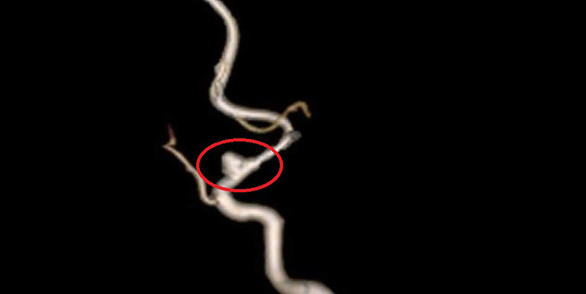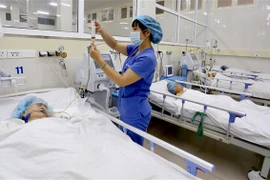 The cerebral aneurysm sac (in circle) of the 3-year-old boy. (Photo courtesy: HCM City's Children's Hospital)
The cerebral aneurysm sac (in circle) of the 3-year-old boy. (Photo courtesy: HCM City's Children's Hospital) Earlier this month, HCM City’s Children's Hospital reported a three-year-oldchild faced a month of hospitalisation due to a haemorrhagic stroke.
The boy living inVinh Long Province was playing with his friends then suddenly fell to the floor,had convulsions and lost consciousness.
He was transferred tothe Children's Hospital where tests showed signs of bleeding in the head.
The boy had digitalsubtraction angiography (DSA) of his cerebral vessels to find the cause of thestroke.
The result of thecerebral haemorrhage was that the boy had a cerebral aneurysm sac.
Cerebral aneurysm isa common disease and one of the leading causes of death in the elderly, said HuynhHuu Danh, one of the doctors of the surgical department who treated the boy.
While cerebral aneurysms are becoming more common among younger people,the boy is the youngest Danh has seen with a cerebral vascular aneurysm.
The boy will have stents inserted to stop the cerebral aneurysm sac frombreaking again when his health is stable, said the doctor.
This was not the first case of a child suffering a stroke. Last year, thehospital also successfully treated a three-year-old boy who had astroke caused by infarction.
Strokes could happen to babies and there are also cases of infants getting strokes,according to the doctor.
Strokes are typically either a hemorrhagic stroke or an ischemic stroke.Strokes in children are more often hemorrhagic than ischemic, the doctorsaid.
The most common cause of hemorrhagic stroke in children is due to the ruptureof a cerebral vascular malformation or the rupture of the cerebral aneurysm.They can also be caused by blood clotting disorders.
The dangerousness of the stroke depends on the severity of the infarctionor bleeding.
Once a stroke has been recorded, it is identified as a very serious illness,whether it happens to a child or an adult.
For cerebral hemorrhagic strokes, if the treatment is not timely, there may bedamage to the nerve centres in the brain stem leading to a risk of brain lossand death.
Most of the treatment methods for hemorrhagic stroke in children are notdifferent from adults. But strokes in children are harder to recognise than inadults, leading to late diagnosis and treatment.
Stroke symptoms vary from case to case.
In children from six years and older, the symptoms are the same as in adults,including hemiplegia, distorted mouth and slurred speech. But in youngerchildren, the symptoms are unclear.
The most common signs are that the child will be fussy, have a headache, blurryvision and hemiplegia so it is difficult to recognise and easily confused withother diseases.
The "golden" time to save the life of children with cerebralhemorrhagic stroke is six hours from the time the child's symptoms appear tosurgery.
In case the child is hospitalised late, even if the surgery is successful, thechild must practise physiotherapy for six months and the maximum recoveryrate is only about 80 percent.
For children, stroke prevention is a huge challenge worldwide. Unlike adultswhose strokes stem from factors such as hypertension, smoking, and fibrosis,atherosclerosis and obesity, for children, there are none of these risks.
The causes are mostly congenital, cerebral venous artery malformations orcerebral aneurysm vesicles that do not manifest clearly without rupture.Therefore, it is very difficult to prevent strokes in children.
According to Danh, the only way to save a child with a hemorrhagic strokeis to quickly take them to the nearest medical facility.
Without timely treatment, children would be at a very high risk ofdisability, even death, the doctor said./.




























